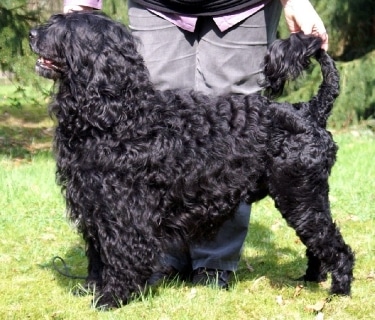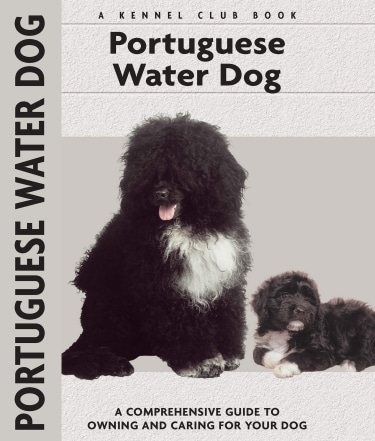
The Portuguese Water Dog is medium sized, well muscled and has either a wavy or curly coat. There are also two different clips, a retriever clip which is when the entire coat is trimmed to no more than an inch long. The lion clip is when the hair is trimmed very short on the muzzle and just below the mid-section to the hindquarters. This type of clip is said to help aid the dog while swimming.
The Portuguese Water Dog is an ancient breed that originated in Portugal, possibly as far back as 700 B.C. At one time, they were found all over the Portugal coast, but later due to changes in fishing methods, they were located primarily in the Algarve region. Possible ancestors include the Kerry Blue Terrier, current day Poodle and the Irish Water Spaniel.
The Portuguese Water Dog is excellent fisherman’s companion. These working dogs are trained to retrieve fish and tackle, guard, dive and act as a courier between ships. They have great stamina and are known to work very long days – never tiring and always happy to complete a task for his master.
The first Portuguese Water Dog was brought to the United States by Deyanne and Herbert Miller in 1968. The Portuguese Water Club was founded in Connecticut in 1972 and the breed was officially recognized by the American Kennel Club in the Working Group in 1983.
Height: The height for a Portuguese Water Dog (measured at the shoulder) is between 17 to 23 inches (43 – 58 cm).
Weight: The ideal weight for a Portuguese Water Dog is between 35 to 60 pounds (16 – 27 kg).
Coat Type: The Portuguese Water Dog has a very thick coat. There are two types: wavy and curly. The wavy type is longer, has a slight wave (no curls) and has a bit of a sheen. The curly type is lackluster and dense with tight cylindrical curls. The coat is abundant all over the Portuguese Water Dog’s body except for underarms and groin where it is thinner. The Portuguese Water Dog is a single coated breed and sheds very little. Grooming is involved. The coat will continue to grow, so it must be trimmed about every two months. There are two clips: retriever cut and the lion cut. In addition, to maintain the coat, it’s important to brush the coat at least every other day which also helps to prevent matting.
Color: The color of the Portuguese Water Dog’s coat can be “black, white, and various tones of brown; also combinations of black or brown with white.” AKC Standard.
Temperament: The Portuguese Water Dog is loyal, active and extremely intelligent. He is best suited for an owner who is very firm, consistent and patient. The Portuguese Water Dog is generally very obedient, but if he feels he can outsmart his master and take charge, he will. This breed does very well with children and is happiest when he is with his family. The Portuguese Water Dog makes a good watchdog, he is fun and he is humorous. He is very smart and does very well in obedience training and agility skills. The Portuguese Water Dog must be socialized starting at a very early age and it’s recommended to continue throughout his life. This is an athletic and active breed that needs daily exercise which is essential for his physical and mental well being. These exercises are all considered ideal: walking, jogging, swimming, free play and playing fetch.
Health Concerns: The Portuguese Water Dog is prone to Canine Hip Dysplasia, Juvenile Dilated Cardiomyopathy, Storage Disease (GM-1) and Progressive Retinal Atrophy (PRA). The average life span of a Portuguese Water Dog is between 12 – 14 years.
Special Interest:
• In its native country Portugal, the Portuguese Water Dog is known as Cao de Agua which means dog of water.
• The Portuguese Water Dog has been described in many writings as a Lion Dog
• President Barack Obama had two Portuguese Water dogs (Bo and Sunny).
Classifications:
AKC: Working Group
ANKC: Utility – Group 6
CKC: Working – Group 3
FCI: Group 8 Section 3 Waterdogs
KC: Working
NZKC: Utility
Kennel.com Recommends Portuguese Water Dog
Portuguese Water Dog
 Kennel.com – Complete Guide to Dogs The Dog Lovers Guide
Kennel.com – Complete Guide to Dogs The Dog Lovers Guide